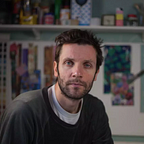Mystery Coast
We’re launching a new game. Last summer we began prototyping concepts, learning from our experience making and launching Avo. Avo — and his millions of players and fans from all over the world — have taught us a lot. (This father and son made a movie with the Avo using the AR mode which currently stands at 20.1m views!)
While Avo broke ground with a new playable dimension inside video, at its heart was a linear story, and a narrative tied to game mechanics. In itself this was satisfying and novel — a great and new thing we’re deeply proud of — but it was not easy to make real changes to the mechanics of the game once it was launched. There was no core loop, and no abstracted elements that could develop or change independently.
Our studio has always been struck by the r/oddlysatisfying, r/powerwashing and r/lasercleaningporn threads in Reddit. They’re visually incredibly appealing, and represent satisfying mechanics in their own right. Part of the attraction, in watching someone power-wash a teddy bear, laser-clean some metal, or the excellent power washing crossovers with r/penmanshipporn, is that you feel: I want to do that. Even in the absence of a story, or people, you can watch LOADS of it.
At the same time, our CTO Nick was building something new: Signet, a full 3D volumetric painting system, based on signed distance fields (enough to say, he’s clever and it’s complex), that has enabled a kind of cleaning mechanic and rendering that fitted the qualities we wanted to see. We found that in early tests, just as drawing lines in Avo felt great, this felt great too — to clean a beautiful, rare object. To feel your finger push into the object which was part of a scene in video. So new, and so satisfying! And we were also interested in what this could mean for TV and TV narrative. What might episodic TV in advertising-length format look like?
These instincts married with an aim, this time around, to explore and develop a core game loop that we could live-operate, led to Mystery Coast.
The game follows a young protagonist, Storm, and the mystery of her long lost mother. With her crew, she dives shipwrecks for lost treasures and artefacts, piecing together her family history. The narrative in the game is technically abstracted from the game mechanics. Rather than interactions and game mechanics driving the story, and vice versa, the different elements of the game — narrative video, the workshop, the map and so on — are complementary but technically independent. This means that as a studio we can build as we go, opening up huge new vistas of possibility. We can build new tools for restoration in the workshop, come up with completely new stories, or refine those we have, based on where our players find most satisfaction.
We’re excited about this: a TV series where season 1 will look different in six months than it does now, because it’s changed based on the experience of people playing it; a game that can change and grow all the time depending on what we know. And what we can learn won’t be just a general idea, or broad metrics; it will be the specific and intimate minutiae that only games data offers. We can bring the nuance and detail and forensic understanding of game analytics and live-operation, to video and TV.
Mystery Coast is part of an emerging wave of products that combine qualities of TV series with free-to-play-game mechanics. It takes some of the behaviours and tropes of mobile gaming, and extends them to an extreme degree, with enormous love and attention, into something new. As with Avo, we are trying again to think of TV and video differently, to put a new kind of agency into people’s hands, and to create new forms of interaction.
